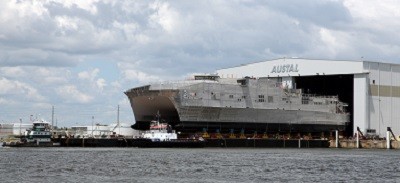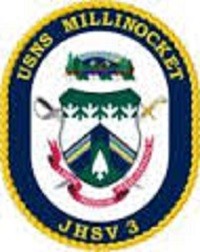
(JHSV-3: displacement 2,362; length 338'; beam 93'; draft 13'; speed 21 knots; complement 41, troop capacity 312; armament 4 .50 caliber machine guns; aircraft up to 2 Sikorsky MH-60 Seahawks; class Spearhead)

The first naval vessel to be named in honor of the towns of Millinocket and East Millinocket, Maine.1
The Department of Defense initially slated the Army to operate five of the anticipated U.S. fleet of ten joint high speed vessels (JHSVs). Secretary of the Navy Ray Mabus announced on 30 May 2012, however, the change of the third vessel’s name from Fortitude to Millinocket, in light of her transfer to the Navy (which had occurred in 2011).
Millinocket (JHSV-3) was laid down on 3 May 2012 at Mobile, Ala., by Austal; launched on 5 June 2013; sponsored by Mrs. Karen G. Mills, wife of President Barry Mills of Bowdoin College, Maine; and was placed in service on 21 March 2014.
The predominant colors of dark blue and gold on her seal are traditionally associated with the Navy; blue to represent the sea and gold to signify excellence.
The Military Sealift Command (MSC) operates the joint high speed vessel, which can embark a company of Marines or soldiers for a voyage of up to 1,200 nautical miles at an average speed of 35 knots in sea state 3 (sea state 3 equals wave height up to 4.1 feet). Millinocket has a flight deck for helicopters, and a loading ramp to enable vehicles to quickly drive on and off the ship. The ramp is designed to accommodate the limited piers and quay walls often encountered in developing countries. The ship’s shallow draft further enhances her littoral operations and port access.
Detailed history under construction.
Mark L. Evans
20 May 2015
The Maryland Steel Co., Sparrow’s Point, Md., built steam freighter Millinocket (3,274 tons) in 1910. When World War II began, A. H. Bull & Co., Inc., New York, operated the ship. German Type IXC U-boat U-129 (Korvettenkapitän Hans-Ludwig Witt) sank Millinocket (Master Lewis W. Callis), while she steamed with a load of bauxite ore en route from Georgetown, British Guiana, to Mobile, Ala., off La Isabella, Cuba, (23°12' N, 79°58' W, at 2303 on 17 June 1942). Callis and ten crewmen died, and 24 men survived. Witt briefly questioned the survivors and then provided them with a first aid kit. Cuban boats rescued the survivors the following day.


